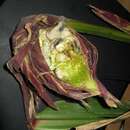en
names in breadcrumbs


Dieser Artikel wurde aufgrund von formalen oder inhaltlichen Mängeln in der Qualitätssicherung Biologie im Abschnitt „Mykologie“ zur Verbesserung eingetragen. Dies geschieht, um die Qualität der Biologie-Artikel auf ein akzeptables Niveau zu bringen. Bitte hilf mit, diesen Artikel zu verbessern! Artikel, die nicht signifikant verbessert werden, können gegebenenfalls gelöscht werden.
Lies dazu auch die näheren Informationen in den Mindestanforderungen an Biologie-Artikel.
Die Brandpilzverwandten (Ustilaginaceae) sind eine Familie aus der Ordnung der Brandpilzartigen (Ustilaginales). Die Familie umfasst 17 Gattungen und 607 Arten.[1]
Viele Arten produzieren natürlicherweise ein großes Spektrum an wertvollen Chemikalien (z. B. Sekundärmetabolite, TCA-Zyklus Intermediate) mit wachsendem biotechnologischen Interesse.[2] Zu diesen Chemikalien zählen Polyole (Erythritol, Mannitol), organische Säuren (Itaconsäure, Malat, Succinat), extrazelluläre Glycolipide (Mannosylerythritol Lipide, Ustilaginsäure), Eisen-bindende Siderophore und Tryptophan-Derivate.[3][4]
Dieser Artikel wurde aufgrund von formalen oder inhaltlichen Mängeln in der Qualitätssicherung Biologie im Abschnitt „Mykologie“ zur Verbesserung eingetragen. Dies geschieht, um die Qualität der Biologie-Artikel auf ein akzeptables Niveau zu bringen. Bitte hilf mit, diesen Artikel zu verbessern! Artikel, die nicht signifikant verbessert werden, können gegebenenfalls gelöscht werden.
Lies dazu auch die näheren Informationen in den Mindestanforderungen an Biologie-Artikel.
Die Brandpilzverwandten (Ustilaginaceae) sind eine Familie aus der Ordnung der Brandpilzartigen (Ustilaginales). Die Familie umfasst 17 Gattungen und 607 Arten.
The Ustilaginaceae are a family of smut fungi in the order Ustilaginomycetes. Collectively, the family contains 17 genera and 607 species.[1]
Ustilaginaceae naturally produce a wide range of value-added chemicals (e.g. secondary metabolites, TCA cycle intermediates) with growing biotechnological interest.[2] Reported metabolites are polyols, organic acids, extracellular glycolipids, iron-chelating siderophores and tryptophan derivatives.[3][4] Polyols, such as erythritol (ery) and mannitol, for example, have large markets as sweeteners for diabetics and as facilitating agents for the transportation of pharmaceuticals in medicine.[5] Itaconic, L-malic, succinic, l-itatartaric, and l-2-hydroxyparaconic acid are organic acids produced by many Ustilaginomycetes.[4] Applications for itaconic acid are for example the production of resins, plastics, adhesives, elastomers, coatings, and nowadays itaconate is discussed as a platform chemical in the production of biofuels.[6] Malic acid is used in many food products, primarily as an acidulant.[7] Succinic acid is utilized as a precursor to pharmaceutical ingredients, such as additives, solvents, and polymers, but also as a food additive and dietary supplement.[8] Another category of metabolites produced by smut fungi contains extracellular glycolipids, such as mannosylerythritol lipids and ustilagic acid.[9][10] These lipids have biosurfactant properties and can be used in pharmaceutical, cosmetic, and food applications and are known for their strong fungicidal activity on many species.[3]
The Ustilaginaceae are a family of smut fungi in the order Ustilaginomycetes. Collectively, the family contains 17 genera and 607 species.
Ustilaginaceae es una familia de hongos tizón en el orden Ustilaginales. Contiene 18 géneros y 607 especies,[1] entre ellas el carbón o carboncillo de los cereales[2] (Ustilago hordei (Pers.) Lagerh.).
Ustilaginaceae es una familia de hongos tizón en el orden Ustilaginales. Contiene 18 géneros y 607 especies, entre ellas el carbón o carboncillo de los cereales (Ustilago hordei (Pers.) Lagerh.).
Les Ustilaginaceae sont une famille de champignons basidiomycètes de la classe des Ustilaginomycetes.
Cette famille comprend de nombreuses espèces de champignons phytopathogènes qui provoquent la maladie du « charbon » chez les plantes. Elle regroupe au total 17 genres et 607 espèces[1].
Selon Catalogue of Life (3 octobre 2014)[2] :
Selon ITIS (3 octobre 2014)[3] :
Selon NCBI (3 octobre 2014)[4] :
Les Ustilaginaceae sont une famille de champignons basidiomycètes de la classe des Ustilaginomycetes.
Cette famille comprend de nombreuses espèces de champignons phytopathogènes qui provoquent la maladie du « charbon » chez les plantes. Elle regroupe au total 17 genres et 607 espèces.
De Ustilaginaceae vormen een familie van de klasse branden (Ustilaginomycetes) uit de onderklasse van de Ustilaginomycetidae.
Er zijn 18 geslachten bekend met 607 soorten, die tot deze familie behoren[1].
De taxonomische indeling van de Ustilaginales is als volgt:
Familie: Ustilaginaceae
Geslachten:
De Ustilaginaceae vormen een familie van de klasse branden (Ustilaginomycetes) uit de onderklasse van de Ustilaginomycetidae.
Er zijn 18 geslachten bekend met 607 soorten, die tot deze familie behoren.
Głowniowate (Ustilaginaceae Chevall.) – rodzina grzybów znajdująca się w rzędzie głowniowców (Ustilaginales)[1].
Pasożyty bezwzględne roślin z rodziny wiechlinowatych (Poaceae). Pomiędzy komórkami porażonych roślin tworzą strzępki o poprzecznych przegrodach bez otworów. Strzępki te dojrzewając przekształcają się w ciemno zabarwione ustilospory. U większości gatunków kiełkujace ustilospory wytwarzają 4-komórkową przedgrzybnię, a tworzące się na niej sporydia są haplobiontami. Wyjątkiem jest np. Ustilago nuda, u której między komórkami przedgrzybni następuje kopulacja, jest więc ona diplobiontem[2].
Pozycja w klasyfikacji według Index Fungorum: Ustilaginales, Ustilaginomycetidae, Ustilaginomycetes, Ustilaginomycotina, Basidiomycota, Fungi[1].
Według aktualizowanej klasyfikacji Index Fungorum bazującej na Dictionary of the Fungi do rodziny tej należą rodzaje[3]:
Głowniowate (Ustilaginaceae Chevall.) – rodzina grzybów znajdująca się w rzędzie głowniowców (Ustilaginales).
Ustilaginaceae é uma família de fungos na ordem Ustilaginales. Contém 18 géneros e 607 espécies.[1]
Ustilaginaceae é uma família de fungos na ordem Ustilaginales. Contém 18 géneros e 607 espécies.
见内文
黑粉菌科(学名:Ustilaginaceae)是属于黑粉菌纲黑粉菌目的真菌,寄生在禾本科、蓼科、莎草科等植物上,可引起植物的黑粉病。[1]该科共有17属、607种。[2]